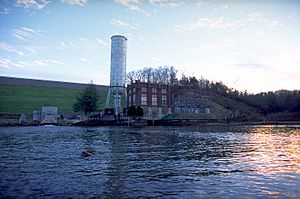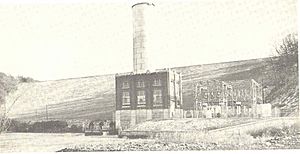Blue Ridge Dam facts for kids
Quick facts for kids Blue Ridge Dam |
|
|---|---|
 |
|
| Official name | Blue Ridge Dam |
| Location | Fannin County, Georgia, United States |
| Coordinates | 34°52′57″N 84°16′48″W / 34.88250°N 84.28000°W |
| Construction began | 1925 |
| Opening date | July 31, 1931 |
| Operator(s) | Tennessee Valley Authority |
| Dam and spillways | |
| Impounds | Toccoa River |
| Height | 167 feet (51 m) |
| Length | 1,000 feet (300 m) |
| Reservoir | |
| Creates | Lake Blue Ridge |
The Blue Ridge Dam is a big structure that helps make electricity from water. It's built on the Toccoa River in Fannin County, Georgia. This dam is the first of four dams on the Toccoa/Ocoee River. The Tennessee Valley Authority (TVA) owns and runs all of them. The dam creates a large body of water called Lake Blue Ridge, which covers about 3,300 acres. This lake is located at the edge of the Blue Ridge Mountains.
Contents
Where is Blue Ridge Dam?
The Blue Ridge Dam is located about 51 miles (82 km) up the Toccoa/Ocoee River. It's close to where the states of Georgia, Tennessee, and North Carolina meet. The Toccoa River flows northwest from the dam. After about 10 miles (16 km), it crosses into Tennessee and changes its name to the Ocoee River. Further downstream are the other Ocoee dams.
Surroundings of the Dam
The area around Blue Ridge Dam and its lake is part of the Chattahoochee National Forest. The city of Blue Ridge, Georgia is just a few miles west of the dam. A bridge for U.S. Route 76 crosses the river right below the dam.
How Blue Ridge Dam Works
Blue Ridge Dam is an earth-fill dam. This means it's built mostly from compacted earth. It stands 167 feet (51 m) tall and is 1,000 feet (300 m) long. The dam can produce 22 megawatts of electricity.
Water Flow and Power Generation
The dam has a special part called a saddle spillway. This spillway is separate from the main dam by a small hill. It can release a lot of water, up to 55,000 cubic feet (1,600 m³) per second. To make electricity, water flows from a 192-foot (59 m) tall concrete intake tower. It then goes through a 14-foot (4.3 m) wide steel pipe called a penstock, which is 1,050 feet (320 m) long. This pipe carries the water to a large machine called a turbine, which spins to create power. A 180-foot (55 m) tall surge tank helps control the water pressure.
Lake Blue Ridge Details
Lake Blue Ridge has about 60 miles (97 km) of shoreline. It can hold a lot of water, which helps prevent floods. The water level in the lake usually changes by about 20 feet (6.1 m) each year. Sometimes, water is released from the dam on purpose. These releases create small rapids on the Toccoa River downstream, which are fun for rafting and kayaking.
History of Blue Ridge Dam
The Toccoa Electric Power Company started building Blue Ridge Dam in 1925. This company was part of the Tennessee Electric Power Company (TEPCO). TEPCO also ran other dams in Tennessee, like Ocoee Dam No. 1 and Ocoee Dam No. 2. The dam officially started making electricity on July 1, 1931. When it was finished, it could produce 20 megawatts of power. It was very modern for its time and only needed six people to run it. Later on, upgrades helped it produce even more power, reaching 22 megawatts.
TVA Takes Over
In 1933, the Tennessee Valley Authority (TVA) was created. The TVA was given control over the Tennessee River area, which included the Toccoa River. TEPCO didn't agree with this at first and went to court. But in 1939, the U.S. Supreme Court said the TVA law was valid. So, TEPCO had to sell all its dams and power plants to TVA for $78 million. Blue Ridge Dam was part of this sale, costing TVA $5 million.
Keeping the Dam Safe
Soon after the dam opened in 1931, the long pipe (penstock) that carries water to the turbine partly broke. To stop this from happening again, the TVA used to lower the lake's water level a lot during dam inspections. This happened about every five years. However, a big project started in 2010 to fix the penstock and make other parts of the dam stronger. These repairs mean they won't need to lower the lake level so much for future inspections, which is better for the lake and the environment.


